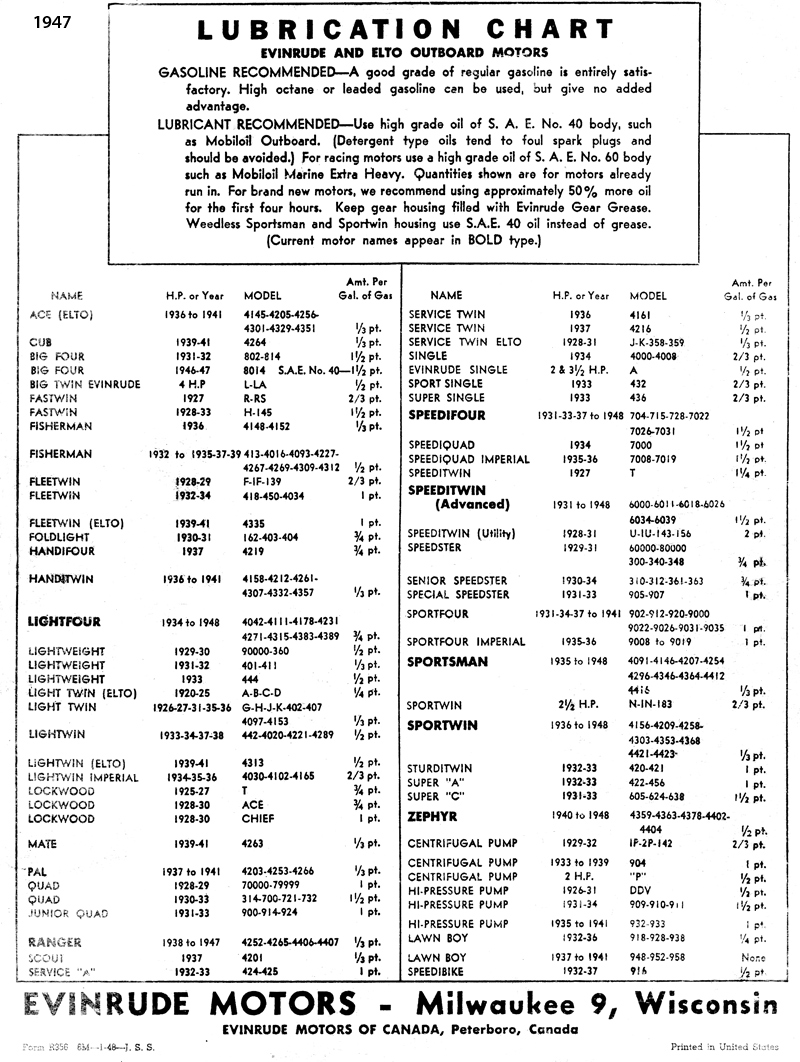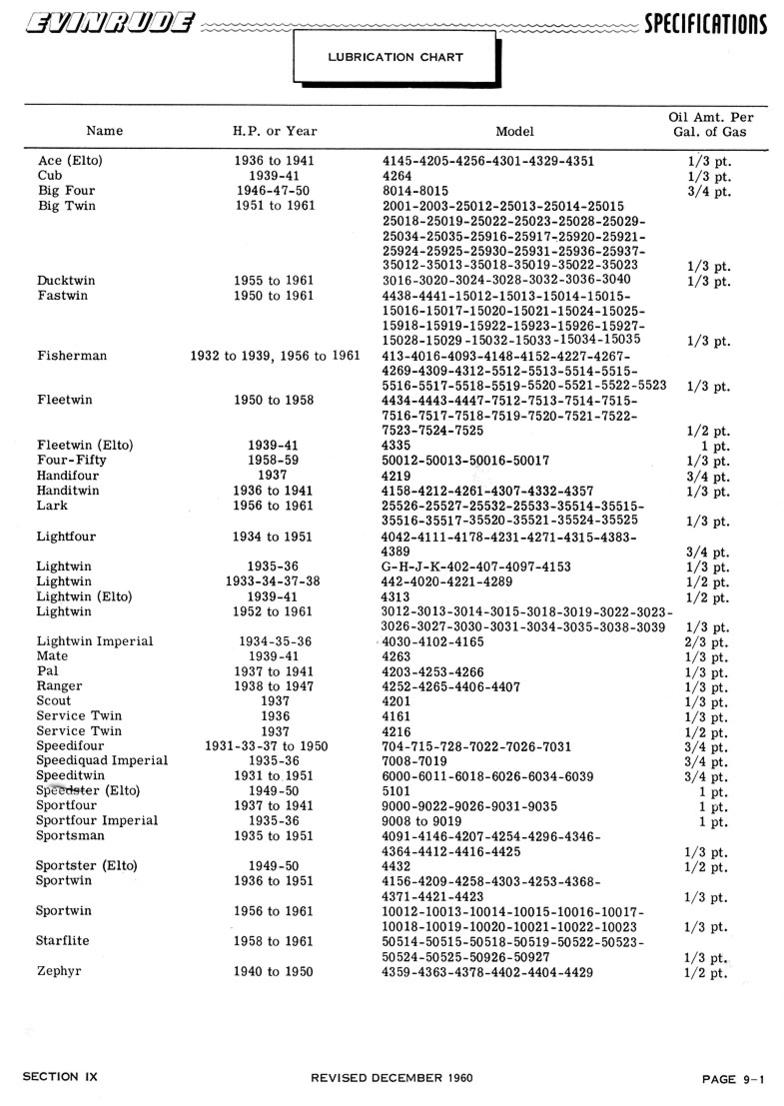Home › Forum › Ask A Member › SpeediFour and SpeediTwin oil ratio?
- This topic has 8 replies, 6 voices, and was last updated 8 years, 8 months ago by
 RICHARD A. WHITE.
RICHARD A. WHITE.
-
AuthorPosts
-
May 9, 2016 at 1:53 pm #4247
I am getting ready to run these motors on a boat and am curious about the proper oil ratio. On the tank it says to use 1&1/2 pints per gallon. I also seem to remember reading some other ratio but I can’t find it now. I have no problem using all that oil. Just trying to see if there is information that I missed.
It will keep the bugs away!
May 9, 2016 at 3:14 pm #36294May 9, 2016 at 7:21 pm #36313Jim, I knew I had seen that info somewhere. Thanks. No racing versions here!
I can tell you that with 1&1/2 pints to the gallon they really make same smoke. I am using half ND 40wt and half TWC3.
May 9, 2016 at 11:20 pm #36327Hi Mumbles – Your ’42 chart was upgraded in the 1950s. Here in one from ’47 that hasn’t been upgraded.

In the 1920s and early ’30s oil refining was more art than science. Quality seemed to depend on the phase of the moon. Evinrude did extensive testing (Everything on the motor was supposed to last at least 1000 hours.) Whenever a perceived failure in lubrication happened, the tendency was to add more oil to the gas. The recommended mix for the Racing 460 was a quart to the gallon. (Yes – one gallon of oil to four gallons of gas)
Government funded research during WW2 brought vast improvements in manufacturing and chemistry. Having to meet government specifications brought more uniformity to the oil industry. Further testing proved that much of the piston scoring thought to be from a lack of lubrication, was from carbon deposits from excessive oil flaking off combustion chambers and getting caught between the piston and cylinder wall. This resulted in less oil being recommended. Lubrication charts from the mid 1950s reflect these changes. . . . . . 😀

 May 10, 2016 at 2:04 am #36341quote Garry in Tampa:Hi Mumbles – Your ’42 chart was upgraded in the 1950s. Here in one from ’47 that hasn’t been upgraded.
May 10, 2016 at 2:04 am #36341quote Garry in Tampa:Hi Mumbles – Your ’42 chart was upgraded in the 1950s. Here in one from ’47 that hasn’t been upgraded.Actually, my first two lists are from the ’54 manual which shows they cut down on the amount of oil needed by half from the ’47 manual. The ’60 manual shows 3/4 pint per gallon to, same as the ’54 manual. Maybe by the mid-fifties they realised the motors didn’t need all of that oil recommended earlier if the oils were improving.
May 10, 2016 at 5:06 pm #36375A "Boat House Repair" is one that done without having tools or the skills to do it properly.
-
This reply was modified 6 years, 2 months ago by
Tubs.
-
This reply was modified 3 years, 10 months ago by
 Tubs.
Tubs.
May 14, 2016 at 8:52 pm #36560I have to mention that I was told NOT to use full synthetic to break in a motor because they do not allow the metal to metal contact needed to polish the surfaces. At the same time BRP says there micro finish is so good, "breaking in" in no longer necessary. They are OK to run wide open right out of the box.
High performance Corvette engines are now equipped with Titanium pistons … 🙄

 May 14, 2016 at 11:39 pm #36562
May 14, 2016 at 11:39 pm #36562I can’t readily find penzoil full synthetic, I have been running amsoil synthetic 30:1 (shhhh) in my PO15 and prewar Johnson’s including ERV Johnson’s "after breaking in" with no issue and when I run in test my tank after a week the oil slick is gone, my 2cents 😉
May 15, 2016 at 11:02 am #36570So the question then is this….how much less oil can one use WITHOUT the risk of "smoking" a motor due to lack of oil? If the motor is well used, one could surmise it might need a tad more oil, fresher motors could do with less. I think this brings our " CORRECT OIL RATIO" debate to the forefront in that how can one person with no professional knowledge of lubricity factors, or the original manufactures intent for lubrication have any idea how much less oil we can get away with using. I have watched technical videos showing that on some applications of motors with bushings, not bearings, the thicker oil actually is used to "fill" the gap, thus aiding in sealing the crankcase. Thinner synthetic oils may not work that way, and of course would cause irreparable damage to our motors.
I understand many currently use less oil than what the manufacturers recommend, and everything seems fine. My question is this, has anyone, or I guess how many have done the litmus test of running your motor on proper amount of modern TC 2 cycle oil, noting the amount of smoke, then ran the same motor on the same amount of synthetic, to see if there is a difference in the amount of smoke? I have not. Is it possible that trying to lessen the amount of oil is a knee jerk reaction? I don’t know. But it is a new season and I am going to need to buy some more oil so I might just do that. I would even be willing to try it with my 1914 Evinrude since I generally run it very heavy on the oil. Would this prove or disprove the theory of less synthetic is better? Probably not but as Tubs said, we must be prudent and cautious lest we lose our ability to run our toys…. I will try this experiment and advise, but it will take a bit, I will take video, but it would need to be on a calm day so as not it skew the test….
Regards
Richard
http://www.richardsoutboardtools.com
classicomctools@gmail.com -
This reply was modified 6 years, 2 months ago by
-
AuthorPosts
- You must be logged in to reply to this topic.



